A few high points in the history of 3-D. The first attempt at Three Dimension in motion pictures started in Great Britain with William Freese-Greene. Freese-Greene patented a camera capable of filming 10 photographs a second on celluloid on June 21, 1889. By 1890 he was working on the first stereoscopic film system. In short Freese-Greene was inventing 3-D motion pictures.
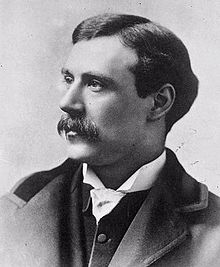
On June 10, 1915 Americans Edwin S. Porter and William E. Waddell presented 3-D movies in Red-Green Anaglyph. That system is still used today, but normally with those Red-Blue glasses you might be wearing right now to see the 3-D in this article.
In 1922 American Harry K. Fairall invented a 3-D camera to make amaglyph motion pictures. He made the first major motion picture to have a public showing. Below are pictures of both Fairall and his camera. Apparently after showing the movie it seems to have vanished and Fairall stopped using the camera.

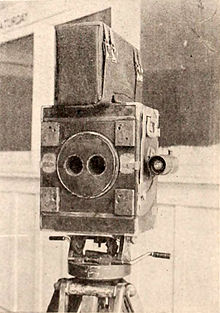
While attending Harvard University, a student named Edward H. Land, took a leave of absence from his studies and developed, on his own, a means of reducing the glare of polarized light. In 1932 he introduced the "Polaroid J Filter". Unknown to Mr. Land, he had created a means for motion pictures to move from the Anaglyph process by improving stereoscopic filming. Had anyone in the motion picture industry been interested, Land was also on the way to creating one of the most innovative camera and film manufacturers in the world.
However, even though shorts were shot in his process it remained a gimmick to motion picture producers. During the Second World War the military used Land's process to photograph enemy targets in three dimensions, but again after the war ended so did the idea of his creation being utilized for any form of photographing until along came Arch Oboler in 1952.
Above, Arch Oboler, standing by a poster for his film, "Bwana Devil"
Oboler started out writing horror scripts for radio in its Golden Age. He took over the Radio Program "Lights Out". That show was pure terror especially on radio when you only had sound effects and his script. He also produced radio, television and motion pictures. Along with being a novelist.
Oboler is important, because most people think the first 3-D motion picture was Warner Brother's "House of Wax" in 1953. Actually the first film was Produced, Directed and Written by Arch Oboler. Sid Pink ("The Angry Red Planet" and "Reptilicus") was his co-producer.
The movie starred Robert Stack, Nigel Bruce and Barbara Britton and was entitled "Bwana Devil", filmed in the Congo, and released in "Natural Vision 3-D" on November 30, 1952. The total costs for Oboler and Pink were $323,000. The motion picture, upon its initial release grossed over $6 million. The story would be remade in 1996 starring Michael Douglas and Val Kilmer as "The Ghost and the Darkness", with a budget of $55 million. Both films are based upon the true story of the hunt for two man eater lions, that stoped the building of the first railway in Uganda,, which at the time was located in British East Africa.
The tag line for the movie was:
The Miracle of the Age!!! A LION in your lap! A LOVER in your arms!

After "Bwana Devil" there would be an additional 61 motion pictures scheduled to be released in 3-D during what is considered it's "Golden Age". These films included Science Fiction, Horror, Westerns, Detective (Film Noir), Adventure, Arabian Nights, Musicals and Drama. In short all genres of movies normally being made, but enhanced by the Three Dimensional process. Obviously I can not cover them all. So I have chosen some examples of these films which I viewed when they first came out during this period.
1953
The big push for 3-D releases happened during 1953. These motion pictures were all over the spectrum as the major studios rushed head first into producing films in this process. Even the minor studios got into the action,
On April 10, 1953 a motion picture was released that the Studio Publicity Department billed this way:
WARNER BROS. Brings You The First Feature Produced By A Major Studio In 3-D!
This of course was Vincent Price in:

The motion picture was actually a remake, but set in the 1890's. The original film was the second all technicolor horror move ever made. The first was "Dr. X" released August 3, 1932 and the second "The Mystery of the Wax Museum" released on February 18, 1933. The female star of both films would become associated not with them, but another motion picture released March 2, 1933. The live action portion she was in being shot during May and June 1932, but the film required stop motion and editing before release. He name was Fav Wray and her third, or second (?) film was "King Kong",
Playing Ivan Igor was Lionel Atwill in "The Mystery of the Wax Museum" and playing Professor Henry Jarrod was Vince Price in "House of Wax".
Atwill in "The Mystery of the Wax Museum".
Price in "The House of Wax".
In both an excellent sculpture in wax who has a museum with beautiful recreations of historic is left for dead as his partner burns the place to the ground to collect the insurance. However, he survives and is now a mad man out for vengeance and the recreation of his Marie Antoinette. People rave at how lifelike his new museum creations are and that's because their real people covered in Wax.
Of note in "House of Wax" is the mute assistance for Vincent Price played by Charles Burchinsky who would have his nose redone and change is last name to Bronson.
Another interesting point about "House of Wax". 3-D creates depth perception and you need to be able to visualize how the set and actors will look on screen. The film's director Andre Toth had only one eye and wore a patch over the other.
Above Andre Toth hams it up on the set for "House of Wax" explaining how he was able to visualize the depth perception aspect. Below the front page of the May 29, 1953 issue of "Variety" about Warner Brothers pictures committing to 20 movies in the 3-D process because of the great box office from "House of Wax".
On May 25, 1953 Universal Pictures had released "It Came From Outer Space" starring Richard Carlson, Barbara Rush and Charles Drake. The motion picture was based upon a short story by Ray Bradbury. The film took two unique angles in telling its story. The first was that the Invaders are not Invaders, but creatures whose space craft malfunction and they crash in the Arizona desert by mistake. The second is that the movie is shown very effectively from the perspective of the space creatures without revealing to the audience their appearance. This plays to their concern of frightening humans as we are not ready to meet them. What they do to achieve their repairs is kidnap, but not harm towns people and assume their shapes.
Here is the marquee of the RKO Hillstreet movie theater. It is interesting in several ways. One is that this was still the time that major studio's owned their own chain of theaters and their own films had priority at them. Another interesting point is that their was a live performance before the movie started. Note that an up and coming Nat "King" Cole was on the bill. All note that the theater was advertising that they had a "Wide Vision Screen" which meant they could handle the new CinemaScope process. Which also meant they were equipped for the new Stereophonic sound system.
Here's a link to the original 3-D trailer:
https://www.youtube.com/watch?v=T6aQkJ9TNXw
Even 3-D movies had their very low budget entries. One released on June 24, 1953 was so bad it's become a Cult Classic for a total budget of $50,000. Which included advertising, food and $4,520.54 so they had a second camera to create the dual strip Polaroid 3-D. The film on its initial run grossed One Million Dollars.
Note in the lower right corner of this poster to make the film seem more than it was. The artist borrowed a sketch of Ray Harryhausen's "The Beast from 20,000 Fathom" which had just come out to rave reviews a week before "Robot Monster".
Here are a few stills.
Here's a link to the film's trailer:
https://www.youtube.com/watch?v=cq9IKsH9BXg
Released on July 26, 1953 Richard Carlson returned to face:
The film was designed an directed by William Cameron Menzies. Menzies designed sets to help convey very eerie mood to the surroundings of the Scottish Castle Carlson inherits. When he abruptly breaks off his engagement and leaves the States for Scotland. His ex-fiancee and her friends find a way to follow. Only to get mixed up in the strangeness of the place and thinking Carlson is going insane, if only the final act in this interesting film was not so laughable when the dark secret is revealed.
Horror and Science Fiction were not, as I have said above, the only motion picture genre to be shot in the Third Dimension. Writer Mickey Spillane's hard nose detective Mike Hammer appeared in a "Film Noir" "I the Jury" released July 29, 1953.
For those into Science Fiction the lead Biff Elliot would appear in 1967 on "Star Trek" in the episode "The Devil in the Dark" during the shows first season. He played the head of the mining operation that uncovers the Horta. The other male lead was Preston Foster who played the "Moon Killer Murderer" in the 1932 horror film "Dr. X". Then their were the two ladies. First was Margret Sheridan from 1951's "The Thing from Another World" and the other was Peggy Castle from 1952's "Invasion U.S.A." and 1957's "Beginning of the End". For further reading on Peggy Castle go to my blog article about her, Allison Hayes and Gloria Talbot.
http://kinescopedreams.blogspot.com/2015/04/three-sisters-of-1950s-science-fiction.html
The plot of the story has Mike Hammer searching for the killer of his best friend. This leads him to a seductive women, but meanwhile his friend on the police force is warning Hammer to stay clear of the case. Sounds somewhat like a lift with the bird of Dashiell Hammett's "The Maltese Falcon".

Keeping with "Film Noir" and starring Robert Ryan, Rhonda Fleming and William Lundigan was a tale of a cheating wife and her lover attempting to kill her husband. The movie was appropriately named :
.png)
From this 2-D still you can visualize how the title would have been in your face in 3-D. The movie was also, for those theaters so equipped, in the new Stereophonic Sound.
During a trip to Southern California's Mojave Desert millionaire Donald Carson, Ryan, breaks his leg after falling off his horse. His loving wife Geraldine, Fleming, leave him there to die and heads for her lover Mining Engineer Joseph Duncan, Lundigan. However, the title of the film comes into play as Robert Ryan battles the heat of the Mojave to get his revenge.
Here's the trailer for "Inferno":
https://vimeo.com/1017891
An expedition to the moon finds 8 Cat-Women the last survivors of a 2 million year old civilization. The women are able to teleport anywhere within their living space. They teleport to the men's quarter's and steal their spacesuits. Their leader plans on going to Earth and conqueror the planet with superior intelligence. As they have the ability of telepathy and reading minds. Love comes into play and saves the day.
The original motion picture was shot in dual strip 3-D requiring two cameras filming the same scene and then the strips are combined for viewing. The film ran 64 minutes and was remade in a slightly different version by Astor Pictures in 1958 as "Missile to the Moon" which ran ten minutes longer. In 1987 John Landis, Joe Dante and others made a spoof of this cheesy cult classic "Amazon Women of the Moon".
Motion picture musicals were a staple in the 1950's so of course some transferred to the 3-D process. One of which I will speak of shortly may well be the best 3-D movie created during the "Golden Age".
.
This little musical was released September 23, 1953 by Paramount Pictures and is the typical light entertainment that was being turned out during the witch hunts of "The House Committee on Unamerican Activities" and the Senate under Joseph McCarthy which led to the "Blacklisting" of people in the motion picture industry.
The film once again starred Rhonda Fleming in "Those Redheads from Seattle". Besides Fleming you had the very popular singer Theresa Brewer in her first screen appearance and actor Gene Barry. Who just the month before had appeared in George Pal's "The War of the Worlds" also for Paramount Pictures. The plot such as it is has Agnes Moorehead playing a newly made widow who takes her four daughters from Seattle to Alaska during the Gold Rush.

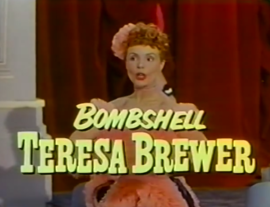
https://www.youtube.com/watch?v=bI9PiS6vFag
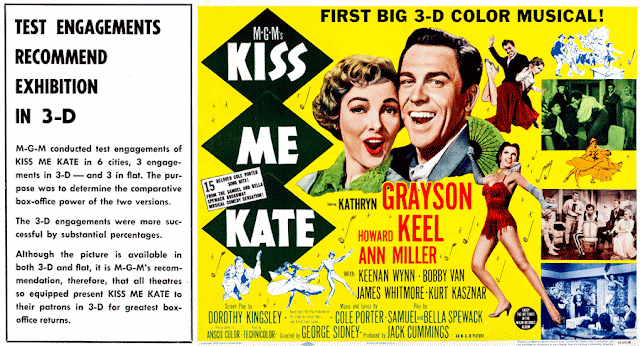
Based upon William Shakespeare’s 1592 play “The Taming of the Shrew” with a script by Sam and Bela Spewack for composer Cole Porter was the 1948 stage production of “Kiss Me Kate”.
The motion picture for Metro-Goldwin-Mayer (MGM) had an adoptive screenplay by Dorothy Kingsley.
The film was produced by Jack Cummings who would afterwards oversee three other popular musicals “Seven Brides for Seven Brothers”, “Can-Can” and “Viva Las Vegas”. The director on the picture George Sidney was the perfect choice as he had a solid musical motion picture resume. Sidney had previously directed Frank Sinatra, Gene Kelly and Kathryn Grayson in 1945’s “Anchors Aweigh”, Judy Garland in 1946’s “The Harvey Girls” and in 1950 both “Annie Get Your Gun” and “Show Boat”. Also of interest to understanding how 3-D worked was the fact George Sidney directed a short in 1941 entitled “Murder in 3-D”. It was about a man spending a night in a deserted old mansion with all the gimmicks flying off the screen.
Then there were the sets designed for the optimum use of a foreground, middle ground and background to bring out the complete 3-D experience for the audience. This was the joint effort of art directors Cedric Gibbons and Urie McCleary and set designers Richard Pefferie and Edwin B. Willis.
Then there was the wonderful chorography of Hermes Pan. Pan had choreographed the major film works of Fred Astaire and Ginger Rodgers including “Flying Down to Rio” and “The Story of Vernon Iren Castle”. The original motion picture “Roxie Hart” and 1945’s Rodgers and Hammerstein’s motion picture musical “State Fair”. Hermes Pan would go on to choreograph the motion picture versions of the Broadway musicals “Silk Stockings”, “Pal Joey” and “Porgy and Bess”, He was the choreographer on the 1963 Elizabeth Taylor, Richard Burton “Cleopatra”. One example of his work is Cleopatra’s entrance into Rome.
The final piece of the 3-D puzzle were the cast. The leads in the film were the popular motion picture dual of Kathryn Grayson and Howard Keel. The excellent dancer and actress Ann Miller, because of Hermes Pan’s chorography would dance off the screen into the laps of the audience during the “Too Darn Hot” number. Playing the two lovable gangsters who want to “Brush Up On Your Shakespeare” are Keenan Wynn and James Whitmore. One of the major dancers showing “All That Jazz” he possessed at the time was a 27 year old Bob Fosse. Once more the perfect cast down to the smallest part.
This link is to a six minute segment from "Kiss Me Kate". PUT YOUR 3-D GLASSES ON NOW AND ENJOY. From www.underground3dmovies.com
https://www.youtube.com/watch?v=XTt_HGmTxf4
The story was simple. An acting troupe is presenting a musical version of Shakespeare’s “The Taming of the Shrew”. However, the two leads are divorced and reflect the characters of Petruchio and Katherine (Kate) they are playing. The actress who is playing Bianca has a brother in the cast playing the part of Gremio. The brother has created a large gambling debt with a local mobster. The mobster has sent Lippy and Slug to collect. The problem here is that the brother signed everything under the male lead Fred Graham’s name. Additionally the actress playing Bianca is now the girlfriend of Fred, but it becomes obvious that Fred and Lilli, his ex-wife, are still in love with each other. They just can’t admit it.
While not in 3-D here is a link to the number "Too Darn Hot" with Ann Miller I mentioned above.
https://www.youtube.com/watch?v=4CYjE9Gv3A4
For those fans of Bob Fosses on my page here is a short clip of his Jazz Dance routine from "Kiss Me Kate". Although not in 3-D note the sets and you can imagine how well they worked in the process.
https://www.youtube.com/watch?v=qw0FSREoaLQ
This is a 3-D preview reel of "Kiss Me Kate" with scenes made for "View-Master". It was one of the gimmicks used by the studios to get more people interested in distributing and showing the movie. "View-Master's" were extremely popular at the time.So this system worked very well and then the company would release them for general sale to the public usually in a three reel set.
I had one of these when I was eight. You took pictures on special film and then it was sent to "Viewmaster" who returned it to you on one of their reels.
Another of those 20 Warner Brothers 3-D motion pictures was released the day after
MGM's "Kiss Me Gate". It was a little western starring John Wayne based upon the "Collier's Magazine" article "The Gift of Cochise" by Louis L'Amour. The screenplay would be turned into a novel by L'Amour taking on the motion picture title of "HONDO".
Below a shot of John Wayne off camera in 3-D during the making of the motion picture.
The story is about a Calvary outrider and scout who meets a women living alone with her son. Her husband has been gone for weeks supposedly rounding up their cattle. In reality he is drunk and gambling at the fort Hondo is heading for and the two meet. The husband becomes angry after a fight with Hondo and follows him with another man. He ambushes the outrider and is killed. Hondo now has to return to the women's ranch to tell her what has happened.. Also the ranch comes under the watch of a group of renegade Apaches lead by War Chief Vittorio played excellently by Australian actor Michael Pate. Pate was also in the motion picture "The Maze" mentioned above. His life is very interesting and I have written an article about both Michael Pate and another excellent character actor Woody Strode. Here is a link to that article:
http://kinescopedreams.blogspot.com/2015/03/woody-strode-and-michael-pate-one.html
In 1921 William Somerset Maugham wrote a short story entitled "Miss Thompson". It was turned into a play called "Rain" in 1923 and the first motion picture version "Sadie Thompson" was a 1928 silent film starring Gloria Swanson. The first sound version was 1932's "Rain" starring Joan Crawford and this was followed by an unauthorized Black cast version in 1946 titled "Dirty Gertie from Harlem U.S.A.".
On December 23, 1953 the 3-D semi-musical version "Miss Sadie Thompson" starring Rita Hayworth and Jose Ferrer opened. The motion picture unlike the 1928 and 1932 versions fell under the censorship of the production code and Sadie Thompson turned from a prostitute into a singer at a bar. The religious fanatic Arthur Davidson does slip in a line that she's a prostitute, but of course he has no such proof and the issue dies quickly. Meanwhile there is a love struck Marine who wants to make Sadie a good women as his wife. The story takes place in Hawaii.
Not the best, but here is the 3-D trailer for the motion picture.
https://www.youtube.com/watch?v=Z8p34q82uCc
1954
This was the year when studios still filmed motion pictures in 3-D, but in a lot of cases even though the outlay in costs had been made initially. Some of these movies would be released only in the normal 2-D format to save production costs. The switch gave those pictures an unique look due to having been shot in the 3-D process. One of the major reasons for this change was on September 16, 1953 20th Century Fox released the first motion picture in the CinemaScope process entitled "The Robe" and it had been a major hit. Widescreen was deemed the real future of the industry. Three Dimension motion pictures were just a gimmick and with complaints from Ophthalmologists about the effect of that process on the human eye audiences were starting to thin out.
On February 12, 1954 Universal Pictures released the third Three Dimensional motion picture starring Richard Carlson "The Creature from the Black Lagoon".
The story has a geology expedition to the Amazon basin after the skeleton hand of some possible sea and land humanoid creature has been discovered. When the expedition returns to the site of the original dig they find the two men left to guard it dead and it is believed that natives attacked.
The actual attack is from a living creature that might be a missing branch on the evolutionary line to man. The decision is made to capture the creature who has plans of his own for the expedition by blocking their only way out of "The Black Lagoon".
The cast was solid 1950's "B+" actors. Besides Richard Carlson you had Richard Denning, Julie Adams, Whit Bissell and Nester Paiva. Pavia at times steals the show as "Lucas" the owner of the tramp steamer "Rita".
For decades Bud Westmore took the credit for designing "The Creature from the Black Lagoon". However, the actual designer not given screen credit was Walt Disney animator Millicent Patrick.
Note the shot above of Ms. Patrick working on the make-up before a scene is shot for the motion picture.
On the same release date as Universal Pictures "The Creature from the Black Lagoon" February 12, 1954 Paramount Pictures released "Jivaro". The 3-D "filmed" motion picture starred Fernando Lamas and Rhonda Fleming. The motion picture feature Nester Paiva, Brian Keith, Lon Chaney, Jr,, a pre-"West Side Story" Rita Moreno and Richard Denning. Fleming hires Lamas to go up the Amazon to Jivaro country to find her missing alcoholic fiancee. Even though she knows they are headhunters.
The motion picture was shot in stereoscopic 3-D, but already the decline in viewers for movies being released in the process was beginning and Paramount Pictures made the decision to only release "Jivaro" aka: "The Lost Treasure of the Amazon" in 2-D. The first time anyone saw the 3-D original print was at "The World 3-D Expo" in Hollywood, California on September 17, 2006 at "The Egyptian Theater".
As I mentioned Jack Warner did the same with "THEM" released a month later. In would appear that the "3-D craze" lasted only one year, but through 1954 other movies with varying forms of success was still released in the process.
Here is a link to the film's trailer. It is not in 3-D, but some scenes show you how much fun the film would have been in that process.
https://www.youtube.com/watch?v=Sg3-X7gonF8
Another film like "Jivaro" was "Dragonfly Squadron" released March 21, 1954 and set during the Korean War. This film was a routine war film of the period, but the only one actually shot in dual camera third dimension. However, the movie was released in 2-D even after the expense of filming it in 3-D. It also had its only showing in the process at "The World 3-D Expo".
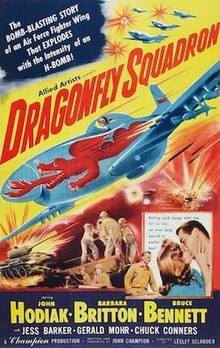
Jack L. Warner's 20 3-D motion pictures included the previous years western "The Charge at Feather River" released on July 11, 1953 starring Guy Madison. Along with Barbara Stanwyck and Fred MacMurray in the big budgeted western "The Moonlighter" released on September 19, 1953. Now Warner decided to attempt the same results "House of Wax" had brought the studio with a film based upon Edgar Allan Poe in Three Dimensions.

Here is a very good description of this motion picture from Turner Classic Movies website's review:
http://www.tcm.com/this-month/article.html?id=466100%7C461425&name=Phantom-of-the-Rue-Morgue
In 1890s Paris, a woman on a rain-soaked street runs toward the camera screaming that there has been a murder in the Rue Morgue. Police Inspector Bonnard (Claude Dauphin) pegs the murder as a crime of passion because of its brutal nature and because no personal items were stolen. Three months later, we see a cabaret show in which knife-thrower Rene (Paul Richards) narrowly misses injuring his partner Yvonne (Allyn McLerie), with whom he has been arguing. They quarrel over Yvonne's relationship with University student Georges Brevert (played by radio announcer-turned-actor Merv Griffin, before he embarked on his lengthy career as a singer, talk show host and television mogul). Yvonne, who wears a bracelet with small tingling bells, is brutally murdered in the same fashion as the Rue Morgue victim. Neighbors witness an agile figure escaping by rooftop, leaping from roof to roof. Bonnard cannot pin the crime on Brevert because he is given an alibi by his friends, psychology professor Paul Dupin (Steve Forrest) and his fiancée Jeanette Rovere (Patricia Medina). Dupin introduces his colleague, Dr. Marais (Karl Malden), a guest lecturer from the zoo who experiments with mice and other animals (including a huge gorilla) to find ways to trigger the "killer instinct" he feels is basic to all creatures. As more young women turn up torn apart by the rooftop "Phantom," evidence is found that points to Dupin's guilt.
Warner Bros. executives seemingly had a checklist of all of the elements that went into House of Wax, so that they might hit upon the same combination of ingredients for their new film. House of Wax was a remake of the earlier Warners horror hit Mystery of the Wax Museum (1933); similarly, Phantom of the Rue Morgue was based on a story that also formed the basis of a previous horror film from the early 1930s, Murders in the Rue Morgue (1932), starring Bela Lugosi. Like House of Wax, Phantom is a period horror filmed in WarnerColor and Naturalvision 3-D and features a crazed protagonist with a past, a befuddled police inspection, a villain's assistant who acts as a convenient red herring, several lovely ladies in distress, the stalwart boyfriend who takes on the case himself, and, of course several shock scenes.
One of the most talked-about scenes in House of Wax had nothing to do with the plot - it showed a barker outside the wax museum gathering a crowd by using a paddleball. The paddleball became an in-your-face gimmick for the 3-D camera, and the makers of Phantom of the Rue Morgue found their own straight-into-the-camera sequence in the form of a knife-throwing demonstration; at least this scene was more logically worked into the plot. The film features several other shots intended to show off the stereo cinematography, and they too are worked into the story. The police are in search of an agile murderer, so in an early scene they survey the talent appearing at a local carnival; this is a handy excuse to photograph trapeze artists and trampoline routines. Director Roy Del Ruth seems to devote more attention to these scenes than he does to the violent attack sequences, which are rather clumsily staged.
Phantom of the Rue Morgue was one of the last feature films in which Charles Gemora, the famous "Gorilla Man," donned his suit for the cameras. Gemora had designed suits and played gorillas in films dating back to 1928 and had played Erik the Gorilla in Murders in the Rue Morgue. By 1954 Gemora had cut back on performing and the majority of the strenuous gorilla scenes in Phantom of the Rue Morgue were done by stuntmen under Gemora's direction. Gemora made many refinements to his gorilla suit over the years, and the 1954 film featured the most expressive simian yet developed, with many innovative design touches, such as a belly appliance made of a water-filled rubber pouch that would realistically sway when in motion.Here also is a link to the preview for the 2-D version of the motion picture:
https://www.youtube.com/watch?v=IfNotY-SrIE
"Jesse James vs the Daltons" released in 3-D on April 2m 1954. This was one of the Westerns directed by William Castle for Columbia Pictures prior to his Horror movie period. The movie is about the possible son of Jessie James contacting the Dalton's to find out the "truth" about his father. Enough said for plot and forget the cast.
Released in May 1954 by 20th Century Fox, but made by Independent company Panoramic Productions was "Gorilla At Large". This 3-D motion picture starred Cameron Mitchell, Ann Bancroft, Lee J. Cobb, Raymond Burr and featured Lee Marvin and Warren Stevens. The story takes place in a circus who comes to a fair grounds to perform. Actually it was filmed on the Long Beach, California pier. It appears that Goliath the Gorilla may have killed a concessionaire named Morse, or has he? The movie is actually very good and performed with a top notch cast. The reason Panoramic Productions made this film was so that 20th Century Fox could concentrate on making motion pictures in their CinemaScope process. Another sign that 3-D was a passing trend with the major studios. In fact to keep costs down only one type of poster was created and stickers were sent to those theaters that wanted to show the 3-D version as both were released simultaneously.
Also in May 1954 Vincent Price was back in 3-D as "The Mad Magician". This Columbia Pictures release featured some very good magic illusions including "the crematorium". Along with Price was Eva Gabor, Patrick O'Neal and John Emery. Price's Magician kills his rival and assumes his identity.
On May 29, 1954 even the master got into the 3-D act. Although he did not want to use the process, but was ordered by Jack L. Warner. The motion picture was "Dial M for Murder" and the master of course was Alfred Hitchcock. The film starred Grace Kelly, Ray Milland and Robert Cummings.

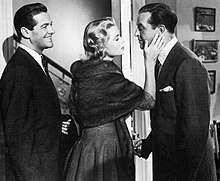
As Hitchcock stated about 3-D:
It's a nine-day wonder, and I came in on the ninth day.The story is simply a husband plans the murder of his wife and his plans go wrong. Hitchcock may have objected to the process, but here is a link to the beautifully filmed 3-D murder scene. Enjoy the master at work
https://www.youtube.com/watch?v=Xi1LmcYRx0E
Jack L. Warner was already aware of the writing on the wall even though he had committed in "Variety" to 20 3-D motion pictures. The 3-D version of "Dial M for Murder" was only released in a few major cities in the country and then was pulled for the more profitable 2-D version.
The output of 3-D motion pictures had slowed down at most major, but a minor like United Artists still had one or two more. On June 5, 1954 Ivan Tors who in four years would bring to television Lloyd Bridges in "Sea Hunt" and ten years later another television program "Flipper" had made his final film of his "Office of Scientific Investigation" trilogy. The first film was 1953's "The Magnetic Monster" and the second from January of 1954 "Raiders to the Stars". This film in 3-D was called "GOG".
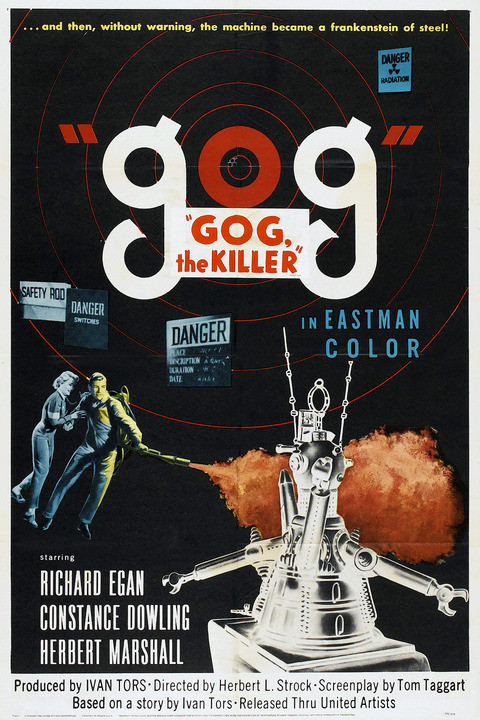
The story is about an underground Government project in New Mexico that is working on sending the first person into space and build the first space station. Acts of sabotage start occurring which seems impossible as everything is controlled by a super computer. The title character "GOG" and its counterpart MYGOG are two multiple purpose robots.
Here is a link to part of the climax of the motion picture in its 2-D version:
https://www.youtube.com/watch?v=xx961KlJcww
On June 14, 1954 a Science Fiction motion picture was released by Warner Brothers studios entitled "THEM!". We can only imagine what it would have looked like in the originally planned Third-Dimension process, but the camera malfunctioned on the first day of shooting and the decision was made not to film the feature in that process.
Bob Furmanek’s excellent 3D Film Archive: “Warner Bros. announced THEM as a widescreen 3-D production in the trades but the day they were going to film a test with the giant ants, the All-Media camera rig malfunctioned and not a single 3-D frame was shot. This is documented in the studio production files. By the time filming commenced for 1.75:1 on September 29, 1953, the plans for 3-D photography had been dropped. However, Joan Weldon can be spotted using a stereo Realist in several scenes.”
Check any complete list of 3-D motion pictures made in 1954 and "GOG" appears to be the last film actually released in the process until 1955. There are two interesting Foreign films during this period that I must bring up.
The first was from the U.K. and was filmed in 3-D. The motion picture is entitled "The Diamond" and was released in the U.K. in April 1954 and then as "The Diamond Wizard" in the United States in July 1954. This was the first known British 3-D motion picture, but according to the "British Film Institute" like many other American films of the year is was released in 2-D only and was not seen until September 2006 at "The World 3-D Film Expo" at the Egyptian in Hollywood.
The movie starred American actors Dennis O'Keefe and Margaret Sheridan. The movie was about an American Treasury Agent teaming up with Scotland Yard to stop a group who are making artificial diamonds out of sugar.

The other Foreign film may, or may not have been shot in 3-D at all. According to reports this Italian film was to have been filmed in the 3-D process, but nobody is sure if it was ever done. As both the original Italian Language motion picture released October 6, 1954 and the English dubbed version released August 17, 1955 were in 2-D. The movie was produced by Carlo Ponti and Dino De Laurentis. It was directed by Mario Camerini who had researched the process and Mario Bava. The motion picture starred Americans Kirk Douglas, Anthony Quinn. Along with Italian actresses Silvana Mangano and Rossanda Podesta and was "Ulysses" based upon Homer's "The Odyssey".
What would have been interesting is had the picture actually been shot in the 3-D process it would have been the first "Widescreen" film in the process. The movie was in the Italian answer to CinemaScope called "Superscope 235". Adding to the mystery is that at least one set of "Preview Disks" were shot in the "View-Master" format to be sent to prospective investors and distributors.
We now come to what was actually the only other film shot and released in Three Dimensions after "GOG" during "The Golden Age of 3-D" and that didn't occur until March 23, 1955.
Universal Studios thought they could bring back 3-D and their attempt was:
Note that also in Universal's attempt to reboot the process it was not billed as "3-D", but with the tag line:
HERE AT LAST! NEW THRILL WONDER 3-D HORRORSCOPE!The audience was to believe this was a new and better process. The obvious first problem was it had been Nine Months since a 3-D picture had been in theaters and almost every film was now in a form of CinemaScope. For a gimmick there was Merian C. Cooper's "Cinerama" three projector 180 degree viewing range system.
The first half of the sequel is a retread of the first film. A new expedition is heading for the Amazon to find the Gill man. The only carry over from the previous film was Nester Paiva once more as Lucas the skipper of the "Rita". The second part of the movie brings the creature back to the United States to a Florida Aquarium for study. After the creature escapes it is finally killed by the local police department who open fire on it. Not to worry it would return without 3-D the following year in "The Creature Walks Among Us". In that film the Gill man is turned completely into an air breathing land creature. The film originally ended with a "Question Mark" as this "New" creature walks toward the Ocean he once lived in and not the words "The End". There had been plans for a fourth film.
That's the difference here and why November 1952 through March 1955 is still "The Golden Age of 3-D".





No comments:
Post a Comment